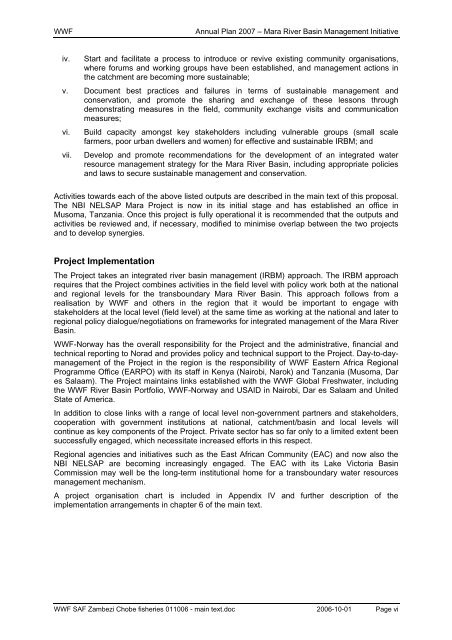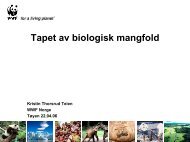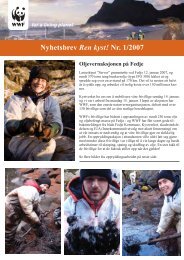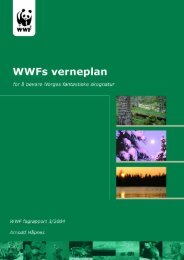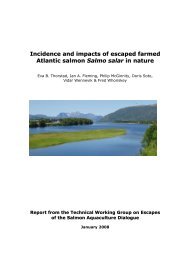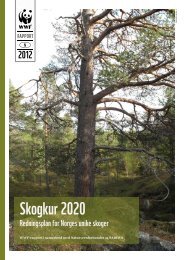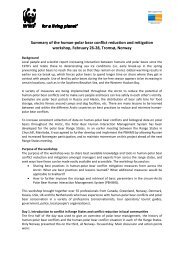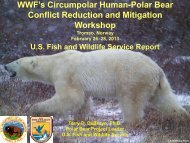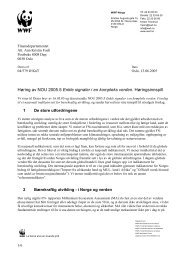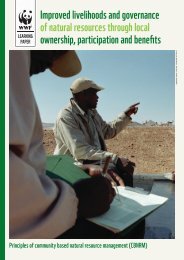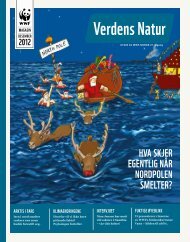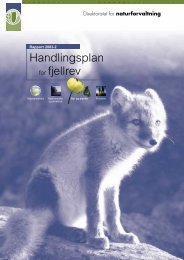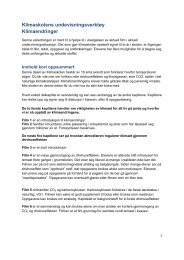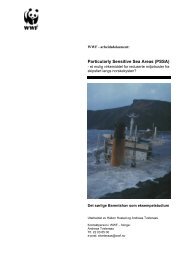WWF SAF Mara River Basin Project Proposal
WWF SAF Mara River Basin Project Proposal
WWF SAF Mara River Basin Project Proposal
Create successful ePaper yourself
Turn your PDF publications into a flip-book with our unique Google optimized e-Paper software.
<strong>WWF</strong><br />
Annual Plan 2007 – <strong>Mara</strong> <strong>River</strong> <strong>Basin</strong> Management Initiative<br />
iv.<br />
Start and facilitate a process to introduce or revive existing community organisations,<br />
where forums and working groups have been established, and management actions in<br />
the catchment are becoming more sustainable;<br />
v. Document best practices and failures in terms of sustainable management and<br />
conservation, and promote the sharing and exchange of these lessons through<br />
demonstrating measures in the field, community exchange visits and communication<br />
measures;<br />
vi.<br />
vii.<br />
Build capacity amongst key stakeholders including vulnerable groups (small scale<br />
farmers, poor urban dwellers and women) for effective and sustainable IRBM; and<br />
Develop and promote recommendations for the development of an integrated water<br />
resource management strategy for the <strong>Mara</strong> <strong>River</strong> <strong>Basin</strong>, including appropriate policies<br />
and laws to secure sustainable management and conservation.<br />
Activities towards each of the above listed outputs are described in the main text of this proposal.<br />
The NBI NELSAP <strong>Mara</strong> <strong>Project</strong> is now in its initial stage and has established an office in<br />
Musoma, Tanzania. Once this project is fully operational it is recommended that the outputs and<br />
activities be reviewed and, if necessary, modified to minimise overlap between the two projects<br />
and to develop synergies.<br />
<strong>Project</strong> Implementation<br />
The <strong>Project</strong> takes an integrated river basin management (IRBM) approach. The IRBM approach<br />
requires that the <strong>Project</strong> combines activities in the field level with policy work both at the national<br />
and regional levels for the transboundary <strong>Mara</strong> <strong>River</strong> <strong>Basin</strong>. This approach follows from a<br />
realisation by <strong>WWF</strong> and others in the region that it would be important to engage with<br />
stakeholders at the local level (field level) at the same time as working at the national and later to<br />
regional policy dialogue/negotiations on frameworks for integrated management of the <strong>Mara</strong> <strong>River</strong><br />
<strong>Basin</strong>.<br />
<strong>WWF</strong>-Norway has the overall responsibility for the <strong>Project</strong> and the administrative, financial and<br />
technical reporting to Norad and provides policy and technical support to the <strong>Project</strong>. Day-to-daymanagement<br />
of the <strong>Project</strong> in the region is the responsibility of <strong>WWF</strong> Eastern Africa Regional<br />
Programme Office (EARPO) with its staff in Kenya (Nairobi, Narok) and Tanzania (Musoma, Dar<br />
es Salaam). The <strong>Project</strong> maintains links established with the <strong>WWF</strong> Global Freshwater, including<br />
the <strong>WWF</strong> <strong>River</strong> <strong>Basin</strong> Portfolio, <strong>WWF</strong>-Norway and USAID in Nairobi, Dar es Salaam and United<br />
State of America.<br />
In addition to close links with a range of local level non-government partners and stakeholders,<br />
cooperation with government institutions at national, catchment/basin and local levels will<br />
continue as key components of the <strong>Project</strong>. Private sector has so far only to a limited extent been<br />
successfully engaged, which necessitate increased efforts in this respect.<br />
Regional agencies and initiatives such as the East African Community (EAC) and now also the<br />
NBI NELSAP are becoming increasingly engaged. The EAC with its Lake Victoria <strong>Basin</strong><br />
Commission may well be the long-term institutional home for a transboundary water resources<br />
management mechanism.<br />
A project organisation chart is included in Appendix IV and further description of the<br />
implementation arrangements in chapter 6 of the main text.<br />
<strong>WWF</strong> <strong>SAF</strong> Zambezi Chobe fisheries 011006 - main text.doc 2006-10-01 Page vi


